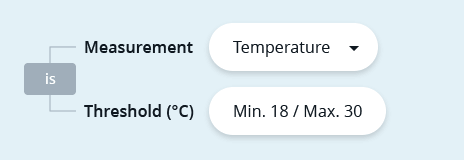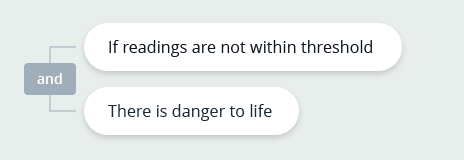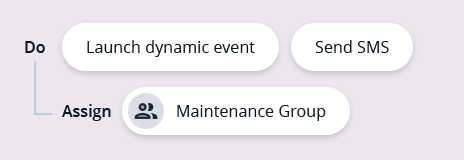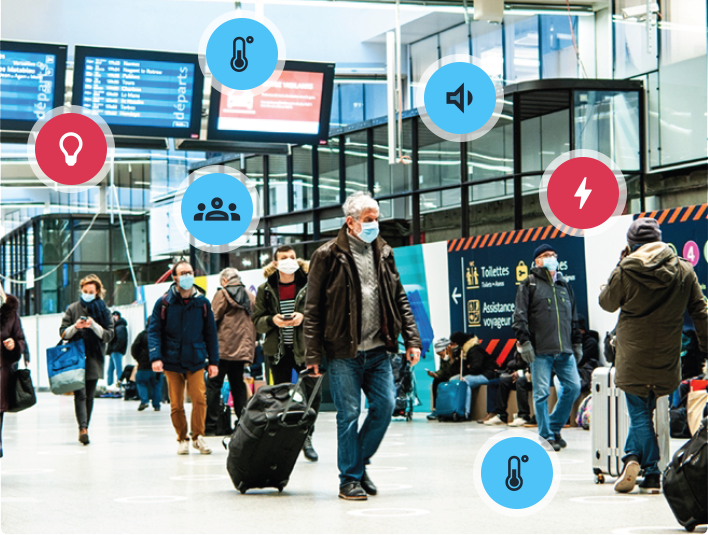- Home
- Dynamic Actions
Dynamic Actions
Dynamic actions generated by the Over-C rules engine make it easy to express verified solutions to difficult problems.

Automate your process with centralised knowledge.
The Over-C’s rules engine helps to automate actions across its IoT-powered platform that would otherwise require manual input. Automated or dynamic actions are defined by dedicated sensor profiles, which can have an unlimited number of IoT sensors connected to them.
Set Triggers
Triggers are combinations of the measurements like temperature or CO2 and the threshold values assigned to them. You can set up single or linked triggers to your dynamic action to tell the rules engine how to differentiate between normal and out-of-normal readings and what to do in the case of the latter.

Define Conditions
Conditions have only two parameters. The default parameter is set to trigger a dynamic action when readings are outside of the normal threshold. An additional parameter allows to automatically upgrade dynamic action from a task to an incident level.

Create Actions
Dynamic action is triggered when readings are out-of-normal. As a result your assigned team gets instantly notified with a custom SMS or notification about the dynamic event.

Measurements to monitor
Single Measurements
Over a dozen different smart measurements can be set with the Over-C platform. There are measurement types for indoor and outdoor environments such as temperature, humidity, air quality and others; occupancy and footfall as well as ESG performance indicators.

Linked Measurements
Sometimes a combination of different measurements provides a more tailored view to fit your organisation's needs for risk management. For example occupancy, CO2 level and temperature can be linked together to trigger a dynamic action of ‘incident’ type in a case of fire. Such an event will automatically broadcast evacuation notices and will call for the security and safety response teams.

Triggers

Triggers are combinations of the measurements like temperature or CO2 and the threshold values assigned to them. You can set up single or linked triggers in Sensor profile to tell the rules engine how to differentiate between normal and out-of-normal readings, and under what conditions dynamic action should be launched.
Threshold can be defined as a range of values, a single minimum or maximum value, or in some cases like ‘occupancy’ or ‘pest control’ it can be set to ‘true/false’ condition.
In a sensor profile you can set up single or linked triggers per a dynamic action. The Over-C platform can help you to monitor and analyse a broad range of different types of measurements such as:
- Environmental measurements:
- Temperature, Electricity, Water, Level monitoring, Humidity, Noise, Air Pressure and Air Quality (AQI)
- Occupancy, Footfall, Traffic and Parking
- Pest control
- Accelerometer, Lift & Escalator
You can create a better targeted dynamic action by linking measurements. For example by linking CO2 and Temperature, you can automatically capture and instantly broadcast an event of rising fire. And if you add Occupancy measurement and ‘Send SMS’ action then people who are on premises will be instantly notified about immediate evacuation from the affected and nearby areas.
Conditions
Conditions have only two parameters. The default parameter is set to trigger a dynamic action when readings are out-of-normal. This cannot be changed.
The additional parameters ‘Danger to Life’ and ‘Potential Property Damage’ allow to automatically upgrade dynamic action from a task to an incident level once an event is triggered. Depending on selection, relevant data is sent to the Analytics Dashboards allowing for further in depth analysis, insights and reporting.

Actions

Dynamic action is triggered when readings are outside a threshold and condition is met. As a result your dedicated team is instantly notified via SMS or notification about the dynamic event.
You can set any or all the types of actions such as:
- Launch dynamic event
- Send SMS
- Send notification
Actions section also includes a feature where individuals and groups can be assigned to form a response team, to receive custom messages or be asked to fill in relevant forms.
Interested in learning more about how Over-C can help?
Call +44 20 7873 2352 or Request a consultation
Dynamic Actions Workflow
Dynamic actions are generated by the set of rules defined inside the sensor profiles. The data captured by IoT sensors is ingested and automatically matched against the rules without any manual input.
Rules that are defined by the sensor profiles are highly customisable to fit your business and customers needs. They automate such activities as data monitoring and analysis, communication and broadcast of events, decision-making and response to any out-of-normal situation arising from the changes in the readings.






